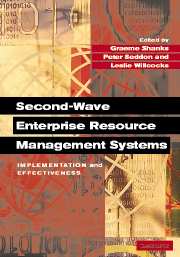Book contents
- Frontmatter
- Contents
- List of Contributors
- Introduction: ERP – The Quiet Revolution?
- Part I Implementation and Effectiveness: Overview
- Part II From Risks to Critical Success Factors
- Part III From Learning to Knowledge
- Part IV Cultural Aspects of Enterprise Systems
- Part V Future Directions
- 18 Continuity Versus Discontinuity: Weighing the Future of ERP Packages
- Index
- References
18 - Continuity Versus Discontinuity: Weighing the Future of ERP Packages
from Part V - Future Directions
Published online by Cambridge University Press: 05 February 2012
- Frontmatter
- Contents
- List of Contributors
- Introduction: ERP – The Quiet Revolution?
- Part I Implementation and Effectiveness: Overview
- Part II From Risks to Critical Success Factors
- Part III From Learning to Knowledge
- Part IV Cultural Aspects of Enterprise Systems
- Part V Future Directions
- 18 Continuity Versus Discontinuity: Weighing the Future of ERP Packages
- Index
- References
Summary
Introduction
As we look back over the contents of this book, one thing becomes very clear. The Introduction's claim that one of the most significant IT developments in recent years has been the widespread implementation of ERP packages by large and medium companies has been substantially justified. Adopting packaged software allowed many companies to replace their ageing legacy systems in time to avoid Y2K problems and brought a variety of other benefits, including strategic business advantages, improved system architectures, and outsourced software maintenance. With so much going for them, ERP packages seem likely to remain popular for some time to come. In this context, it makes sense to build on the picture painted in the Introduction, and anticipate how ERP packages will evolve in the future.
One view of the future can be constructed from an assessment of the issues faced by today's ERP package adopters and the responses under development by ERP package vendors. In this view, the functionality of ERP packages will expand, and the architecture of ERP packages will evolve, in ways that address many of the 2002–2007 business opportunities and technical challenges. This view of the future assumes a high degree of continuity with today's in-house IT management regime; in particular, it involves a continuation of the current division of labour between ERP package adopting organizations and ERP package vendors (Brehm and Markus, 2000). A clear articulation of this continuity view of the future is offered by Davenport (Davenport, 2000a).
- Type
- Chapter
- Information
- Second-Wave Enterprise Resource Planning SystemsImplementing for Effectiveness, pp. 419 - 440Publisher: Cambridge University PressPrint publication year: 2003
References
- 2
- Cited by



